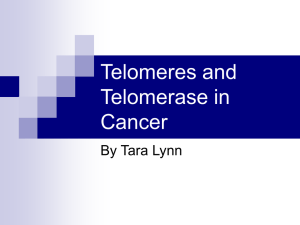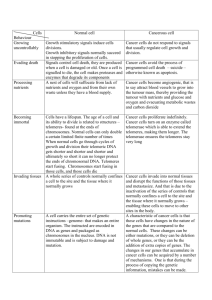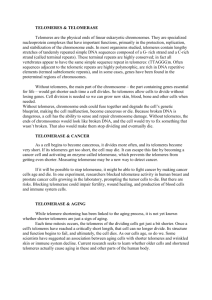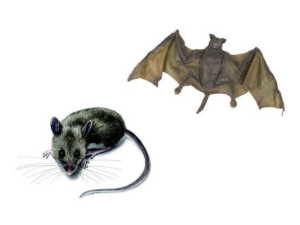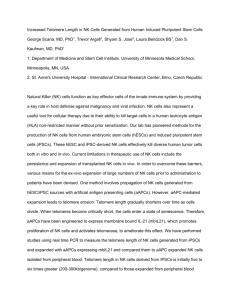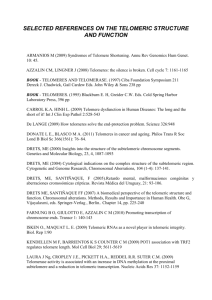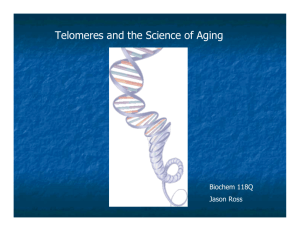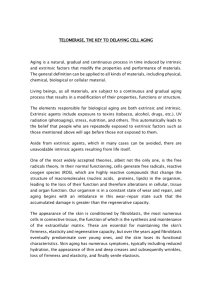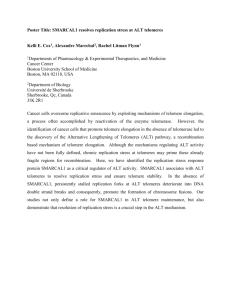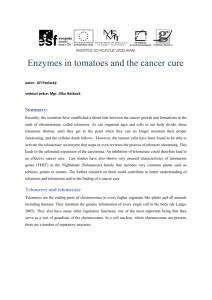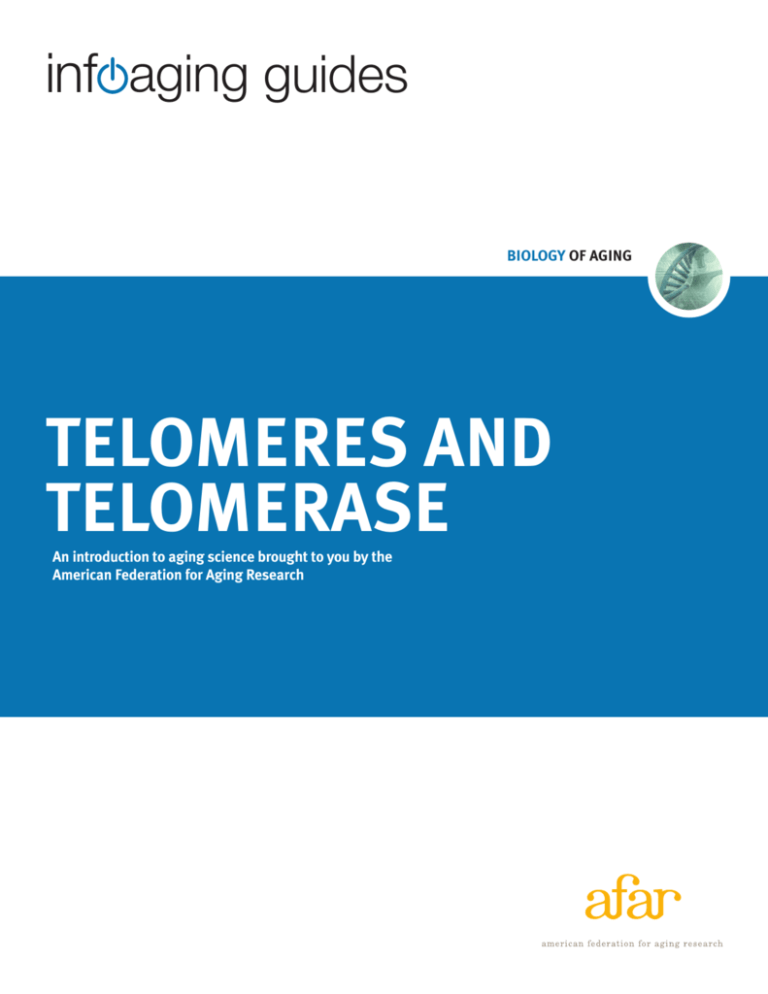
info aging guides
BIOLOGY OF AGING
TELOMERES AND
TELOMERASE
An introduction to aging science brought to you by the
American Federation for Aging Research
WHAT ARE TELOMERES?
Inside the nucleus of ­virtually all
of our cells are 46 chromosomes,
the thread-like packages that
carry our genes. At the tips of
these chromosomes, like the hard
ends of shoelaces, are structures
called telomeres. While they do
not ­contain genes, telomeres
are important for replication or
­duplication of the chromosomes
during cell division. They are
made up of approximately 1,000
to 2,500 copies of a repeated DNA
sequence (the order of ­chemical
building blocks in a stretch of
DNA), TTAGGG.
Why do we need telomeres? When
we are born, we don’t have every
cell our bodies will ever need. As
we grow, we need new skin, bone,
blood, and many other kinds of
cells. Even as adults, we need to
make new cells. For example,
skin cells and those cells that
line our intestines are constantly
replaced. All of these reproducing
cells need their telomeres for cell
division. Without their telomeres,
our cells would be unable to
reproduce at all.
Telomeres also play an important
protective role in our cells. Their
presence prevents important
­genetic material from being lost
during cell division. They also
serve as a “cap” on the ends
of chromosomes, protecting
chromosome ends from appearing broken. This is an important
function, because broken chromosomes trigger unwanted biological
­responses.
HOW TELOMERES WORK
Telomeres are composed of double strands of deoxyribonucleic
acid (DNA), except for the very
ends, called telomere overhangs,
which have single-strands. Many
telomeres, including those from
humans, appear to form t-loops—
special folded structures where the
single-stranded tail of the telomere
is tucked into the more internal
double-stranded part. T-loops are
thought to be important for the
protective-capping function of
telomeres. Research published in
the January 21, 2003, issue of the
Proceedings of the National Academy of Sciences suggests that
the end of a cell’s reproductive life
may actually be triggered when
this loop unravels, either due to
DNA damage or to telomeres that
have become excessively short.
Telomeres tend to get shorter
over time. Two researchers, Alexei
Olovnikov and James D. Watson,
independently recognized that
DNA replication machinery cannot
copy chromosome ends completely. Watson named this the
“end replication problem.” Each
time a normal cell divides, the
ends don’t get completely copied,
and the telomeres become just a
bit shorter. Eventually, telomeres
are so short that the chromosome
reaches a critical length, and no
further cell division can occur.
This cellular aging phenomenon is
known as replicative ­senescence
or the Halyflick limit (discovered
by Leonard Hayflick in 1961).
­Telomere shortening is a ­major
Telomeres are located at the
tips of these chromosomes,
where they act like the hard
ends of shoelaces.
2 | Infoaging Guide to Telomeres and Telomerase
factor limiting cell division. While
some have likened this to a
­genetic biological clock, others
have described the telomere as
a fuse that becomes shorter and
shorter, until it sets off a kind of
cellular time bomb that wreaks
havoc on the cell’s internal workings. Today, researchers continue
to probe the telomeric “timepiece,”
hoping to better understand the
aging process and fight diseases.
WHEN TELOMERES
MALFUNCTION
As mentioned above, telomeres
serve as protective caps on the
ends of chromosomes. From
time to time, defects in this
­capping function can occur, and
may be ­related to the end loops
­unraveling.
The capping function can be lost if
the telomere becomes too short or
is deleted entirely, or if a telomere
protein is missing or mutated.
The body perceives ­uncapped
­chromosomes as broken DNA
ends. In most cells, broken DNA
ends spark one of two repair
mechanisms.
The first is called homologous
­recombination (HR), in which
a broken DNA end is fixed by
­copying the sequence from a
similar, unbroken DNA molecule.
In some situations, recombination
between malfunctioning telomeres
can be frequent enough to keep
cells alive and keep telomeres
very long.
In a second mechanism, the
broken ends of two chromosomes
with telomere failure simply fuse
together. This is called nonhomologous end joining (NHEJ).
Under most circumstances, this
end joining is an effective and
useful DNA repair process. With
malfunctioning human telomeres,
however, it can have devastating
consequences.
If two different chromosomes are
fused by way of telomere end
j­oining, they cannot ­separate
properly during replication. ­During
cell division, a tug of war ­between
the two daughter cells over the
fused chromosome usually ­results
in it being broken into two ­uneven
pieces. Each daughter cell then
inherits a chromosome with
missing or extra DNA and has
one (newly broken) end ­missing
a telomere. That end is free to
potentially cause another round of
chromosome fusion and ­breakage.
Through this mechanism,
­uncapped telomeres can wreak
havoc, killing cells and ­rendering
those that survive genetically
abnormal.
In addition to causing DNA ­repair
in the form of recombination or
end joining, broken DNA ends or
uncapped telomeres can ­trigger
other cellular responses. ­Because
broken chromosomes are a ­severe
form of DNA damage, cells are
often exquisitely sensitive to
their presence. Unrepaired broken DNA ends will often ­trigger
cellular growth arrest, thereby
­preventing any cell division as
long as the broken ends persist.
In some ­human cells, broken DNA
ends can trigger cellular suicide, a
­process known as apoptosis.
Because short telomeres are more
common in older cells, telomere
capping problems may be related
to the development of cancer and
other age-related diseases.
TELOMERES AND AGING
Once a cell’s telomeres have
reached a critically short length,
that cell can no longer divide. Its
structure and function begins to
fail. Some cells even die. In the
laboratory, most human cells can
only divide 30 to 80 times before
they stop reproducing. Cells taken
from older persons and persons
with premature aging syndromes
undergo even fewer divisions
before reaching ­senescence.
Scientists know senescence is
related to telomere length ­because
adding telomerase, an enzyme
that lengthens telomeres, to
cells allows them to reproduce
­indefinitely.
One group of researchers looked
at the cells of people with
­progeria, a disease that ages
young children so rapidly that they
die in their teens with many of the
symptoms of old age. Their cells’
chromosomes have exceptionally
short telomeres, suggesting that
the disease is causing rapid cell
turnover. The cells are using up
their ability to reproduce, which
in turn may contribute to their
­premature aging.
Researchers have also ­developed
a type of laboratory mouse
that has defective telomerase.
­Selective breeding of these mice
produced successive generations
with signs of premature aging and
shortened life spans, ­providing
further evidence of the role of
­telomeres and telomerase in aging.
The entire aging process ­cannot
be explained solely by ­telomere
shortening. To date, evidence
­supporting the relevance of
­replicative senescence and
telomere biology to cancer is
rather strong; however, the direct
­evidence ­linking replicative senescence and ­human aging remains
controversial and is of continued
interest and ­effort of study. Some
point out that no relationship
­exists between initial telomere
length and a species’ life span.
Mice, for example, have much
longer telomeres than humans,
Infoaging Guide to Telomeres and Telomerase | 3
mutations accumulated. Therefore,
they remain pre-malignant and do
not develop cancer.
and live only two years or so. This
leads to the question ­concerning
the role of replicative aging
among different organisms and
whether mice or humans represent
the more ­common mammalian
­paradigm.
TELOMERES AND OTHER
AGE-RELATED DISEASES
AND CONDITIONS
The shortening of telomeres has
been associated with a number
of diseases, many of them agerelated. Shortened telomeres
have been identified in aging
skin, blood, and ­cardiovascular
cells. And the cells of people
with a variety of diseases—from
­atherosclerosis to hepatitis to
blood disorders—have been found
to have shortened telomeres.
THE RELATIONSHIP BETWEEN
TELOMERES AND CANCER
If telomeres give our cells finite
life spans, how is it that cancer
cells seem to possess infinite life
spans? How can they reproduce
and spread infinitely? How do
­cancer cells get around the l­imits
that telomeres impose on our
healthy cells, thereby becoming
immortal?
In many non-human organisms,
telomerase is always active when
cells are dividing. This makes up
for gradual telomere shortening
from replication and cell division.
This activity, regulated by certain
proteins, keeps telomere length
more or less constant.
Human cells are different. In most
of them, telomerase is turned off.
This means telomeres shorten as
cells continue to divide. However,
almost 90 percent of all cancer
cells possess telomerase, while
the remaining employ a mechanism called alternative lengthening
4 | Infoaging Guide to Telomeres and Telomerase
Telomere shortening may
be an active contributor to
the genetic abnormalities
that trigger cancer because
­dysfunctional telomeres drive
genome instability.
of telomeres (ALT) for telomere
maintenance. Telomerase is an
enzyme that “rewinds” our cellular
clocks. It lengthens our shortened
telomeres, replacing bits of DNA
lost in ordinary cell division. If
telomerase stops telomere shortening, then in theory, those cells
with telomerase can live forever.
Since most cancer cells contain
telomerase, researchers believe
it is a critical factor in conferring
­immortality upon these cells.
Inactivation of telomerase and
the resulting telomere shortening likely evolved in humans to
­reduce the incidence of cancer. By
causing replicative senescence,
telomere shortening acts as a
road block to the abnormally high
amount of proliferation associated
with the development of cancer.
It takes many divisions for cells
to ­accumulate enough mutations
to become malignant. Cells that
exhaust their replicative life span
become senescent with only a few
However, telomere shortening itself
may be an active contributor to the
genetic abnormalities that ­trigger
cancer because dysfunctional
­telomeres drive genome ­instability.
In fact, there is ­growing ­evidence
of an association ­between
­shortened telomeres and a greater
risk of cancer ­development in
humans. In addition, ­laboratory
evidence has shown that shorter
telomeres may contribute ­directly
to the ­progression of the ­earliest
stages of certain cancers. In an
experiment involving cells taken
from prostate cancer patients,
­researchers from the Johns
­Hopkins University School of
­Medicine found that telomeres in
cells from precancerous ­lesions
were four times shorter than
telomeres in cells taken from
­surrounding ­normal tissue.
THE ROLE OF TELOMERASE
IN CANCER
Telomerase is the enzyme that
replenishes shortened telomeres
and allows cells to reproduce
indefinitely. Found in only a few
normal human cell types (germline
cells, proliferating stem cells, and
some immune cells), telomerase is
present in as many as 90 percent
of human cancers. This makes
telomerase an attractive candidate
for highly selective cancer drugs.
The evidence that activation
of telomerase is necessary for
most cancers to thrive is strong.
­Indeed, some scientists believe
that telomerase activation is the
main ­pathway by which cancer
cells become immortal, that is,
able to reproduce forever without
limits. Cancer cells generally need
to acquire four-to-six mutations to
become malignant. On average,
a cell with a mutation would need
to expand to at least a ­million
cells (20 doublings) before it had a
chance for another rare ­mutation
to occur. If a cell can ­divide 30
to 80 times, pre-malignant cells
can only acquire one-to-three
­mutations before they stop
­dividing. Replicative aging is thus
a barrier against the formation of
malignant cancer cells. Thus, say
researchers, telomerase activation
is necessary for most, but not all,
cancers to grow.
A number of researchers have
suggested that if telomerase is
required for so many cancers to
flourish, perhaps anti-telomerase
drugs could be developed as
cancer-fighting agents. Some have
suggested that such a drug would
have minimal side effects, since
so few normal cells have active
telomerase. Others caution that
some side effects are possible because some normal cells, among
them dividing germ-line lineages,
stem cells, and some cells in the
skin, blood, and gasterointestial
track, do have telomerase activity.
Potential side effects include:
• Gonadal toxicity. Some normal
telomerase activity is seen
in the cells of the ovary and
testes. Thus, some researchers
speculate that anti-telomerase
drugs could potentially interfere with fertility.
One drawback to the use of
­ nti-telomerase drugs in ­treating
a
cancer is the length of time
­needed for such drugs to have
any effects. If tumor telomeres
are long enough, it might take
many cell ­divisions of ­telomerase
­inhibition before they’re short
enough to kill the tumor cell.
Even if ­anti-telomerase drugs
were ­developed in the near future, they would need to be used
in ­conjunction with faster-acting
anti-cancer drugs. The hope is
that very rare surviving cancer
cells would require so many divisions to cause a relapse that their
­telomeres would become too short
in the absence of telomerase.
Diagnostics
The fact that telomerase is active
in up to 90 percent of all cancer
cells suggests that telomerase
activity may help to diagnose
early cancers so they can be
treated quickly, before the ­cancer
spreads. Theoretically, ­biopsies,
tissue scrapings, and ­biological
fluids such as blood may ­provide
­adequate cell samples for
­detecting telomerase activity. At
a practical level, however, today’s
tests do not yet compare favorably
with other tests, so their clinical
­application has been limited.
• Blood toxicity. Some populations of stem cells, which are
the parents of mature blood
cells, do use telomerase.
­Anti-telomerase drugs could,
therefore, suppress the production of vital blood cells.
• Immune toxicity. Some
­infection-fighting cells use
telomerase normally, so
­anti-telomerase drugs could,
theoretically, weaken our ability
to fight infection.
• Skin toxicity. While most of our
skin cells have little telomerase
activity, the skin stem cells that
repair wounds do have some.
Anti-telomerase drugs might
cause delayed wound healing.
Some scientists believe that telomerase activation is
the main p
­ athway by which cancer cells—such as this
breast cancer cell— become immortal.
Prognostics
Telomerase biology may also help
to identify cancer survivors who
might benefit from ­supplemental
therapies after surgery. In a
­recent study, the expression of
­telomerase was a strong predictor
of long-term outcome. In breast
cancer survivors without lymph
node involvement, 98 percent of
those with the lowest levels of
telomerase expression ­survived
more than 12 years. Among
­patients with the highest levels
of telomerase, there were no
­survivors after 12 years.
THE FUTURE OF TELOMERE
AND TELOMERASE RESEARCH
At the leading edge of cancer
research, scientists are ­currently
looking at ways to help the
­immune system identify and target
malignant cells by way of their
telomerase expression, ­leaving
normal cells unharmed. In one
clinical trial, 12 patients with
advanced prostate cancer were
vaccinated with immune cells that
could do just that. All patients with
detectable levels of circulating
tumor cells showed declines
ranging from six to a thousand
fold. Limited clinical trials are now
­underway to test this approach
with other types of cancer.
Another approach uses ­oncolytic
viruses to attack telomeraseexpressing cells. These are
­genetically engineered viruses
that specifically infect and destroy
cancer cells by penetrating their
membranes and replicating inside
them. The replication is triggered
by the presence of telomerase.
Scientists are currently looking at ways to help the immune
system identify and target malignant cells by way of their
telomerase expression, leaving normal cells unharmed.
6 | Infoaging Guide to Telomeres and Telomerase
TISSUE REJUVENATION
If low telomerase is related to the
shortened telomeres that mark
an aging cell, perhaps we can
“turn on” the expression of this
gene to lengthen the lifespan
of a cell or organ. One goal of
­tissue engineering is to overcome
­organ failure by infusing cells with
­telomerase. A patient donates
cells that are modified in culture
by the ­introduction of telomerase.
The cells are then returned to the
­patient to correct a deficiency.
Thus far, 17 different cell types
have been used to engineer 22
different kinds of tissues. The
limitations of this technology are
considerable, however, emphasizing our limited understanding of
the complexity of aging cells.
The use of a donor’s own cells to
build new tissue has its ­limitations
because of the limited ­lifespan
of most cells—especially cells
from older patients. This ­inability
to ­proliferate, however, can be
overcome if the donor’s cells
are infused with a specific gene,
called hTERT, that switches
on ­telomerase ­expression.
­Telomerase then ­restores length to
shortened telomeres.
In one proposed form of therapy,
cells with shortened telomeres are
donated by a patient. Telomere
length is restored in culture with an
infusion of hTERT. Cells are then
reintroduced in the patient’s body
to restore tissue function. One
application, for example, might be
in arterial bypass grafting in aging
cardiac patients.
While cell therapy offers
­tremendous promise in ­clinical
medicine, the safety issue
­dominates the future ­acceptability
and widespread use. ­Researchers
are grappling with certain
­questions such as: What is the
likelihood for long-term change
that might trigger abnormal tissue
growth? Specifically, what is the
risk of cancer?
The results of a study at Duke
University suggest that telomerase
is not independently capable of
inducing tumor formation. http://
www.ncbi.nlm.nih.gov/pmc/articles/PMC1413782/
The over expression of t­elomerase
activity in cultured cells failed to
result in malignant change in a
number of cell types The results
of various analyses of this Duke
study thus far, suggest no e
­ vidence
of t­umor formation of either the
hTERT cells or the control cells.
Another laboratory at the UT
Southwestern Medical Center has
also reported that long-term effect
of telomerase immortalized human
fibroblast does not show cancerassociated changes. http://www.
ncbi.nlm.nih.gov/pubmed/9916803
example, might hTERT-modified
cells be more dangerous if mutational changes months or years
after transplantation cause the
­activation of oncogenes? Also, is
any potential risk of hTERT gene
therapy acceptable—even when
given to save lives?
Future research must also ­unravel
the phenomenon of cellular
­aging even in newly engineered
­tissues. In the smooth muscle cells
­described above, for example,
­age-related changes to cells were
not reversed by transplantation of
cells modified with telomerase. In
fact, collagen synthesis ­decreases
and consequently reduces
the strength of even robustly
­engineered vessels.
Research into telomeres and
telomerase is still in its early
­phases, but scientists have
learned much in these last few
years. The knowledge they have
amassed and continue to ­pursue
offers enormous potential for
­understanding and perhaps
­controlling the diseases of old age.
While cell therapy appears
to be an exciting field with
­tremendous promise, future
research ­endeavors involving
hTERT cell therapy need to carefully explore long-term risks. For
American Federation for Aging Research (AFAR)
55 West 39th Street, 16th Floor
New York, NY 10018
Phone: (212) 703-9977
Toll-free: (888) 582-2327
Fax: (212) 997-0330
Email: info@afar.org
© 2011 American Federation for Aging Research. All rights reserved.
Websites:
www.afar.org
www.beeson.org
www.geriatricsrecruitment.org

